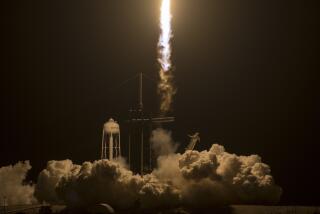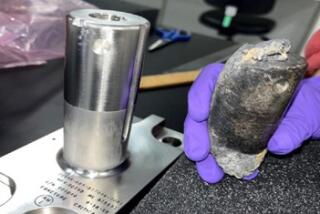Space Shuttle Trucks Into Orbit at Last
- Share via
CAPE CANAVERAL, Fla. — America’s long-haul space truck returned to duty Saturday as the shuttle Atlantis blasted into orbit with a 17-ton load of construction material for the International Space Station.
Atlantis roared off pad 39B on the last possible day of the launch window, after two weeks of delays caused by bad weather and minor mechanical glitches.
“What we saw today was a flawless countdown and a majestic launch,” said NASA Administrator Michael D. Griffin.
NASA cameras captured five incidents of ice and insulating foam flaking off the shuttle’s external fuel tank. At least one piece of foam appeared to hit the underside of the craft.
Analysts at Johnson Space Center in Houston were studying the pictures late Saturday. But space agency officials said it was unlikely the debris could have damaged the spacecraft because the pieces were small.
The first piece of debris appeared to come off about four minutes after launch. By that time, the shuttle was 325,000 feet above Earth, where the air is too thin to accelerate debris to the speeds necessary to cause damage.
“Anything that comes off that late is of no consequence,” said N. Wayne Hale Jr., the shuttle program manager.
Hale and others stressed that the analysis of images taken by more than 100 cameras on the shuttle and at the launch site in central Florida had just begun. It will take several days to fully determine whether the craft is undamaged.
The shuttle’s six-person crew is scheduled to use a boom with attached sensors today to inspect the critical leading edges of the wings, which are covered by delicate heat-resistant reinforced carbon.
Another round of inspections will be performed Monday, when Atlantis docks with the space station. Shuttle mission commander Brent Jett will put the craft into a maneuver resembling a diver’s back-flip as it approaches the space station. That will expose the underside of Atlantis to the station’s three crew members so they can take pictures.
Those precautions were instituted after the Columbia tragedy in 2003. The shuttle was damaged during launch by a piece of foam and broke up during reentry when aerodynamic forces tore open the left wing.
This is the third mission since NASA returned to spaceflight last year, but it will be the first mission in four years to resume work on the half-built space station.
In its payload bay, Atlantis carries a massive truss and a set of solar arrays that will double the amount of power the station produces. When unfurled, the solar arrays will be 240 feet long. Each of the 82 array “blankets” contains 16,400 photovoltaic cells. The truss will serve as a new piece of the station’s spine, where future laboratories and crew containers will be attached.
NASA is hurrying to finish building the station before the shuttle fleet is retired in 2010. This mission will be one of the most complicated in the history of the shuttle program, officials said.
The crew is scheduled to take three spacewalks, beginning Tuesday with the installation of the truss on the port side of the station. The solar array also will be released from its housing. The work will be finished on the spacewalks Thursday and Friday.
“We’re ready to get to work,” Jett said shortly before liftoff.
NASA will have to operate the shuttle near its historical peak of slightly more than four missions a year to complete the space station by the deadline.
Atlantis’ mission was delayed several times, first by bad weather and then by mechanical problems, including an old problem with sensors that shut down the engines when they got low on fuel. The glitches were exacerbated by the fact that Atlantis had not flown in four years. The orbiter underwent extensive modifications after its last launch.
“Not everything in the countdown was easy,” Griffin said. “We had to dodge tropical storms, lightning strikes and things like that.” But in the end, it was a good day for NASA, he said. “I’m proud to be a part of it.”
*
More to Read
Sign up for Essential California
The most important California stories and recommendations in your inbox every morning.
You may occasionally receive promotional content from the Los Angeles Times.










